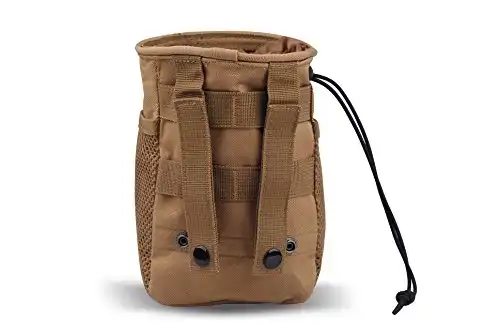Amethyst, with a dreamy purple color, is one of the most sought after semi-precious gemstones. There’s just something about it, no matter what form it takes, that draws people in. It’s a great stone for collectors as well, due to natural variations in the stone.
So, if you’re a new rockhound and looking to start collecting amethyst read on. I’ll break down what makes amethyst itself, what types are out there, and where you can find it on a solo adventure!
What is Amethyst?
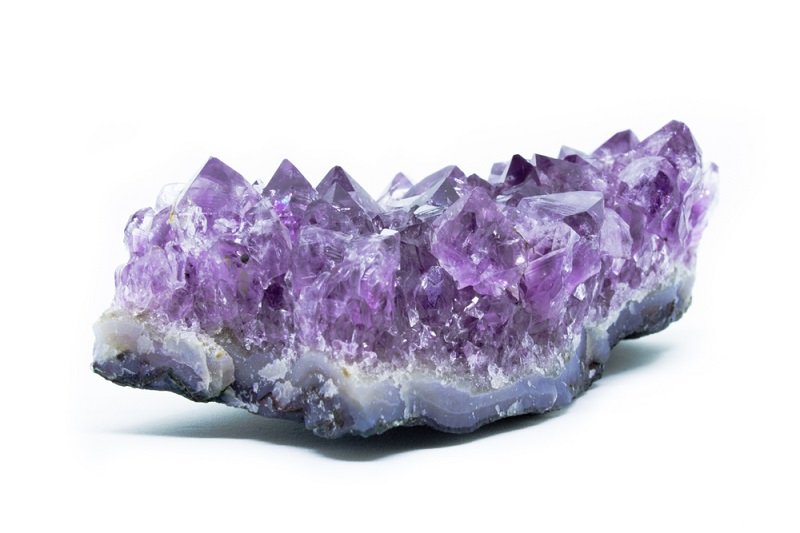
Amethyst is macrocrystalline quartz with iron inclusions that cooled below 420° C(788°F) with a purple coloration. Another 20°C and the formation could have been citrine, and if the crystals form between 420°C and 440°C then the final form is prasiolite.
For most of us, the main form of amethyst is in geodes and crystal points. Both are common in the rock trade, and amethyst geodes range from golf ball-sized to bigger than a person! Since they’re relatively common you can find very affordable specimens of middling quality without difficulty.
The coloration is formed from natural radiation and trace amounts of Fe₃+ ions.
Amethyst can be a valuable gemstone in its own right. Properly faceted amethyst with deep saturation and high clarity are prized for making jewelry.
Amethyst is known for “color zoning” within it’s crystals. It’s common to see darker and lighter splotches of purple in the stone, for instance, and sometimes clear quartz is in there as well.
What Types of Amethyst Are There?
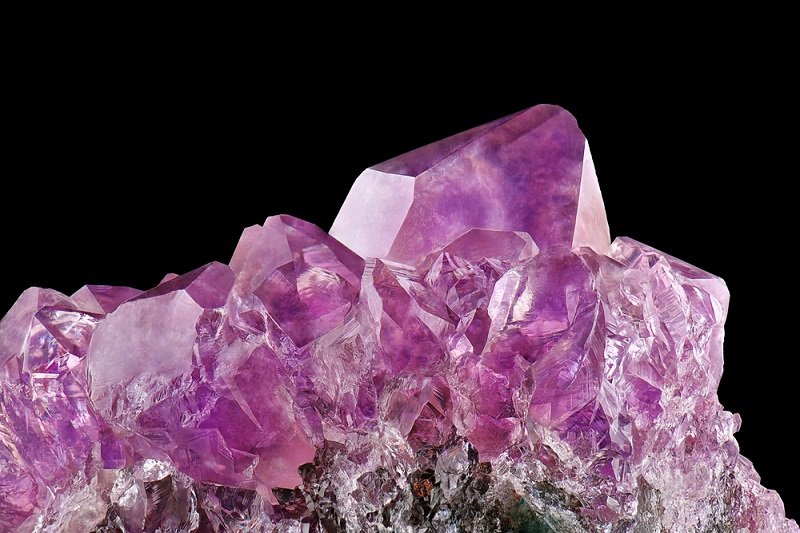
Amethyst occurs in a few variations in nature.
Most people classify their amethyst by the crystal structure. Common finds include:
Geodes
Pockets of amethyst that are lined with crystals. Amethyst geodes are common and vary a lot in color and quality. If you’re into very large geodes, amethyst is a good stone to look into, since natural formations get huge.
Clusters
Smaller formations of crystals, often sticking off a white or clear base.
Points
Singular crystals with a terminated point. They’re usually hexagonal like regular quartz crystals.
Grape Agate
Clusters of ball-shaped formations. Grape agate occurs with druzy, making it macrocrystalline. Grape agate just happens to sound catchier than botryoidal amethyst.
The Uses and Value of Amethyst
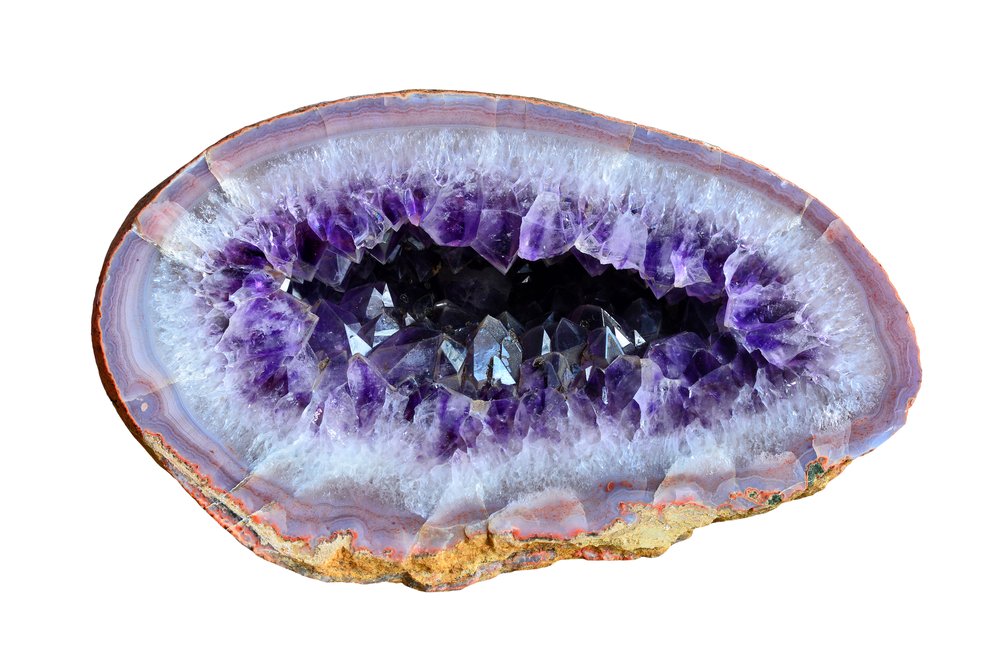
Amethyst is worked as a gemstone for jewelry as well. Cabochons and slabs are often typed by the pattern. The most common example is Chevron amethyst, which forms with a characteristic V-formation.
If you’re into collecting gemstones, you may be confused by amethyst pricing. Gemstones range from pennies to hundreds of dollars, and size doesn’t seem to be a big correlation.
Amethyst is valued for dark coloration and the undertones in the stone when used as a gemstone. The grade of stone makes a far larger difference in price than size.
Amethyst grading is based on color saturation, clarity, and visible inclusions. Ideal amethyst is purple with hints of red and high clarity. When you’re looking at a stone in person the difference between pale, lavender amethyst and the bold purple of top-shelf stuff is striking.
Buyer Warning: “Green Amethyst” and Synthetic Amethyst
On occasion, you’ll stumble across stones described as “green amethyst.” This a misnomer, and it’s often used in a deceptive manner.
The stone known as green amethyst commercially is the mineral prasiolite. More than that, nearly all prasiolite on the market has been subjected to either heat treatment or ionizing radiation to bring out the color.
Prasiolite, even the treated kind, can be a beautiful stone but without a certificate from an accredited gemologist you’ll never know if it’s natural.
Occasionally a “pink amethyst” or other unique stone will make an appearance. These are usually treated in some way, so do your due diligence so you know what you’re getting.
Synthetic amethyst isn’t very common, but it does pop up on occasion. You’ll mainly find it in surprisingly high-grade and low-priced cut gemstones. It’s usually identified by its lack of inclusions, but the color match is very close in most cases.
Where Can I Find Amethyst?
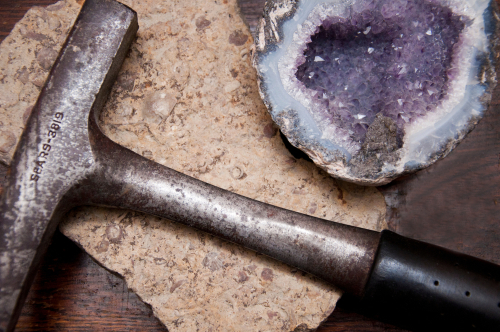
Amethyst is found across the world, with the most famous deposits occurring in Brazil. Of course, you probably don’t have access to a commercial mining operation that will let you dig either.
Fortunately, there are a lot of hot spots for this purple crystal spread across the USA. It’s a common occurrence, although quality varies between different mines.
The best spots are in:
- Arkansas
- Georgia
- Arizona
Looking for information on rockhounding in your state or around where you live? Easily find all of our articles by individual states!
On top of that, a lot of places where quartz crystal is collected also have amethyst.
There aren’t as many amethyst sites as you’ll find with stones like quartz or opal, but there are paid digs open to the public. Jackson Crossroads Mine is probably your best bet if you’re only looking for amethyst crystals.
Amethyst is also found in the Morefield Gem Mine, which offers the unique opportunity to dig in microcline/amazonite. They’re not currently open, but it’s a great experience to look forward to.
Amethyst is of some commercial use, so a lot of smaller deposits are mined privately. Rockhounds are a tight group, but if you’re active in the community chances are you’ll find a good spot sooner or later.
Most often, collectors go to a mine with more varied offerings and happen to pick up a few along the way. If you absolutely love the stuff, there are a few spots it’s the main find but most of the time it’s just going to be an exciting part of various other minerals.
How Do I Collect Amethyst in the Field?
Amethyst collection is much the same as quartz. The crystals form in an identical matter and it’s often found in the same spots. It just happens to have a touch of iron that changes the color mixed into the crystalline matrix.
Gearing Up
The first thing you need to do is make sure you have appropriate gear for digging.
Most mines require you to bring your own tools, but every rockhound should own an E-tool and a rock pick at the bare minimum.
Make sure you have all of the following:
- Rock Pick- A light rock pick is great for prying crystals and cracking open possible geodes. The gold standard is the base model Estwing but any solid brand will do.
- Entrenching Tool- The preferred shovel of rockhounds everywhere. I recommend a military surplus model, but any decent folding shovel does fine.
- Safety Glasses- Not Optional. You may not look cool when cracking rocks, but you’ll also eliminatethe risk of losing an eye.
- Work Clothes- Self-explanatory, jeans, a t-shirt, and some kind of cover works in most places. Just be sensible. No open toed shoes.
- Leather Gloves- Some rockhounds consider these essential, the rest have scarring on their hands. Not required, but strongly recommended. Doubly so for those who don’t usually do physical labor.
- Water- Many places that are hotbeds for amethyst are also hotbeds for dehydration. Bring an appropriate amount of water, then add 50%. As long as you have extra water is great for examining specimens.
Most sites will rent or sell equipment on the spot, but you’ll be paying a markup, Just get your own set, you’ll be a lot happier.
For some areas you’ll also need heavier digging equipment. Pick axes and sledge hammers are a good idea if you’re going to be breaking a lot of stone.
Most areas are rather hot in the summer, and often very remote. Make sure that you’re not putting yourself at risk, especially if you have any health conditions.
Locating Amethyst in the Field
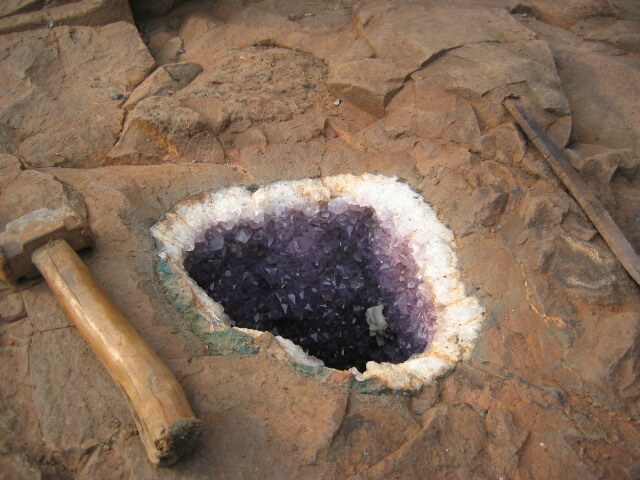
If you’re on a paid dig, you’re in luck and you’ll be pointed in the right direction. Paid digs are a great way to collect some specimens for your collection, and there’s something to be said for having a crystal you dug yourself.
In any case, you’re looking for much the same conditions that quartz occurs in. Most often you’ll be looking through mud and clay, or looking for mud and clay deposits in igneous stone.
When you dig into the mud, you should be a bit gentle to avoid damaging the stone. Most of the time it will come out easily enough, allowing you to check for any crystals contained within. Some points can be quite small, so look closely.
In other locations, geodes are the most common form of crystal. In that case you’ll be looking for spherical nodules with a bumpy exterior. We have a small guide for those who want a more in-depth way to identify them.
When you liberate amethyst from host rock, it’s often a good idea to retain the matrix. It makes for a good visual display and clusters are worth more that way.
The key to digging amethyst is to be methodical and work deliberately. If you have a good location, you’ll find good crystals as long as you take your time. In most locations it’s easy to fill a backpack or a few buckets over the course of a day.
Like any other stone, amethyst has its own quirks you’ll learn along the way. The next step is just to put your foot out the door and get ready for an adventure in collecting amethyst!
- Online rock and mineral club for collectors of all levels!
- Find community with like-minded rock and mineral enthusiasts.
- Monthly Giveaways!
- Free Access to Entire Digital Library of Products (current and future products)*


